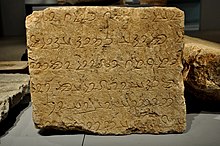lingvo.wikisort.org - Alphabet
Inscriptional Pahlavi is the earliest attested form of Pahlavi scripts, and is evident in clay fragments that have been dated to the reign of Mithridates I (r. 171–138 BC). Other early evidence includes the Pahlavi inscriptions of Arsacid era coins and rock inscriptions of Sassanid kings and other notables such as Kartir.
| Inscriptional Pahlavi | |
|---|---|
 Inscribed stone block from the Paikuli inscription | |
| Script type | Abjad
|
| Direction | right-to-left script |
| Languages | Middle Iranian languages |
| Related scripts | |
Parent systems | Aramaic alphabet
|
| ISO 15924 | |
| ISO 15924 | Phli (131), Inscriptional Pahlavi |
| Unicode | |
Unicode alias | Inscriptional Pahlavi |
Unicode range | U+10B60–U+10B7F |

Letters
Inscriptional Pahlavi used 19 non-joining letters:[1][2]
| Name[A] | Image | Text | IPA[3] |
|---|---|---|---|
| Aleph | 𐭠 | /a/, /aː/ | |
| Beth | 𐭡 | /b/, /w/ | |
| Gimel | 𐭢 | /ɡ/, /j/ | |
| Daleth | 𐭣 | /d/, /j/ | |
| He | 𐭤 | /h/ | |
| Waw-Ayin-Resh | 𐭥 | /u/, /o/, /v/, /ʕ/, /r/ | |
| Zayin | 𐭦 | /z/ | |
| Heth | 𐭧 | /h/, /x/ | |
| Teth | 𐭨 | /tˤ/ | |
| Yodh | 𐭩 | /j/, /eː/, /iː/, /d̠͡ʒ/ | |
| Kaph | 𐭪 | /k/, /ɡ/ | |
| Lamedh | 𐭫 | /l/, /r/ | |
| Mem-Qoph | 𐭬 | /m/, /q/ | |
| Nun | 𐭭 | /n/ | |
| Samekh | 𐭮 | /s/, /h/ | |
| Pe | 𐭯 | /p/, /b/, /f/ | |
| Sadhe | 𐭰 | /t̠͡ʃ/, /d̠͡ʒ/, /z/ | |
| Shin | 𐭱 | /ʃ/ | |
| Taw | 𐭲 | /t/, /d/ |
Numbers
Inscriptional Pahlavi had its own numerals:
| Value | 1 | 2 | 3 | 4 | 10 | 20 | 100 | 1000 | |
|---|---|---|---|---|---|---|---|---|---|
| Sign | Image | ||||||||
| Text | 𐭸 | 𐭹 | 𐭺 | 𐭻 | 𐭼 | 𐭽 | 𐭾 | 𐭿 | |
Numbers are written right-to-left. Numbers without corresponding numerals are additive. For example, 24 is written as 𐭽𐭻 (20 + 4).[1]
Unicode
Inscriptional Pahlavi script was added to the Unicode Standard in October, 2009 with the release of version 5.2.
The Unicode block for Inscriptional Pahlavi is U+10B60–U+10B7F:
| Inscriptional Pahlavi[1][2] Official Unicode Consortium code chart (PDF) | ||||||||||||||||
| 0 | 1 | 2 | 3 | 4 | 5 | 6 | 7 | 8 | 9 | A | B | C | D | E | F | |
| U+10B6x | 𐭠 | 𐭡 | 𐭢 | 𐭣 | 𐭤 | 𐭥 | 𐭦 | 𐭧 | 𐭨 | 𐭩 | 𐭪 | 𐭫 | 𐭬 | 𐭭 | 𐭮 | 𐭯 |
| U+10B7x | 𐭰 | 𐭱 | 𐭲 | 𐭸 | 𐭹 | 𐭺 | 𐭻 | 𐭼 | 𐭽 | 𐭾 | 𐭿 | |||||
| Notes | ||||||||||||||||
Gallery
- Inscriptional Pahlavi text from Shapur III at Taq-e Bostan, 4th century
- Kartir's inscription at Naqsh-e Rajab
- Coin of Ardashir I (r. 224–42) with Inscriptional Pahlavi writings
- Sasanian relief with Inscriptional Pahlavi monogram ʾpr, which stands for abzūn farr, meaning "May his farr increase!"
References
- Everson, Michael; Pournader, Roozbeh (2007-08-24). "L2/07-207R: Proposal for encoding the Inscriptional Parthian, Inscriptional Pahlavi, and Psalter Pahlavi scripts in the SMP of the UCS" (PDF).
- Livinsky, BA; Guang‐Da, Zhang; Samghabadi, R Shabani; Masson, Vadim Mikhaĭlovich (March 1999), Dani, Ahmad Hasan (ed.), History of civilizations of Central Asia, Multiple history, vol. 3. The crossroads of civilizations: A.D. 250 to 750, Delhi: Motilal Banarsidass, p. 89, ISBN 978-81-208-1540-7.
- Daniels, Peter T.; Bright, William, eds. (1996). The World's Writing Systems. Oxford University Press, Inc. pp. 518. ISBN 978-0195079937.
Wikimedia Commons has media related to Inscriptional Pahlavi.
Текст в блоке "Читать" взят с сайта "Википедия" и доступен по лицензии Creative Commons Attribution-ShareAlike; в отдельных случаях могут действовать дополнительные условия.
Другой контент может иметь иную лицензию. Перед использованием материалов сайта WikiSort.org внимательно изучите правила лицензирования конкретных элементов наполнения сайта.
Другой контент может иметь иную лицензию. Перед использованием материалов сайта WikiSort.org внимательно изучите правила лицензирования конкретных элементов наполнения сайта.
2019-2025
WikiSort.org - проект по пересортировке и дополнению контента Википедии
WikiSort.org - проект по пересортировке и дополнению контента Википедии



